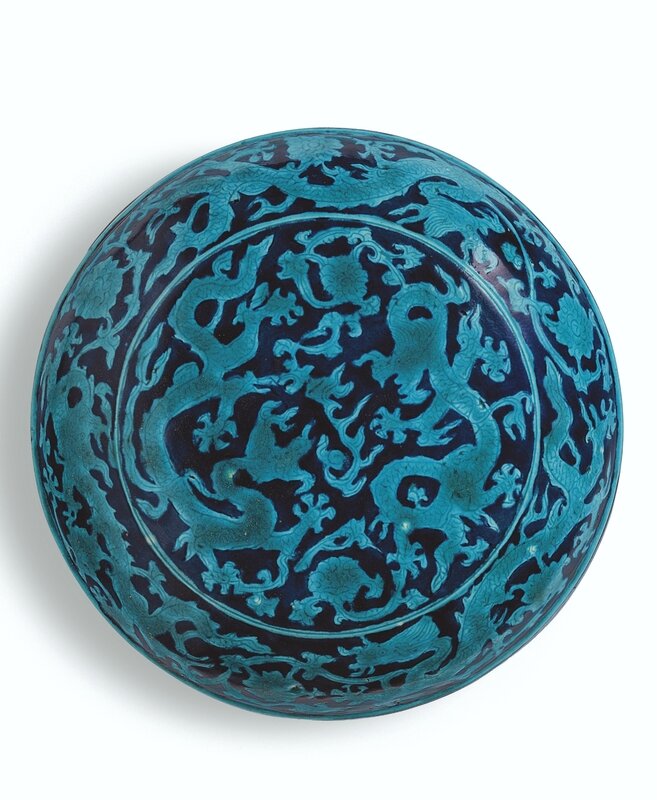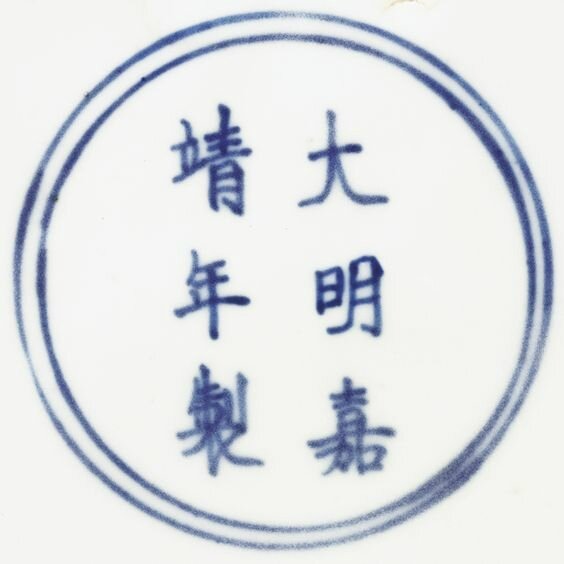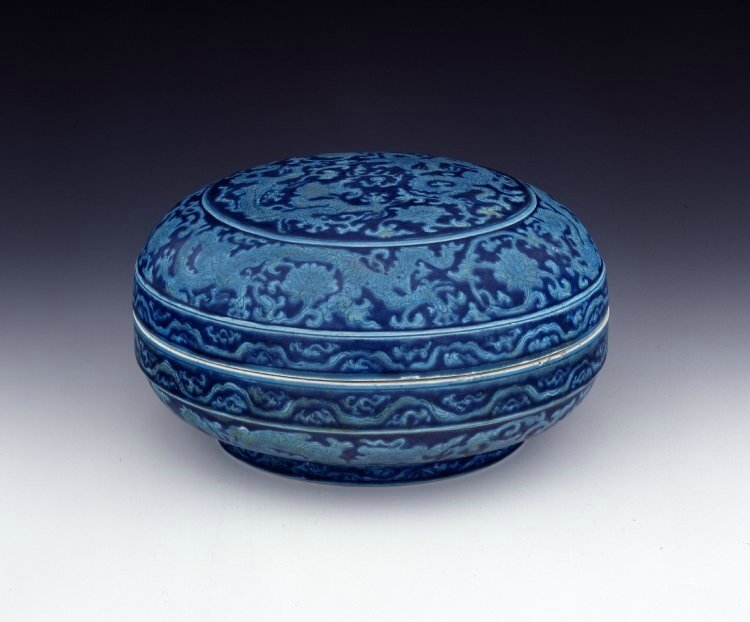A rare turquoise and blue ''dragon' box and cover, Mark and period of Jiajing (1522-1566)
Lot 31. A rare turquoise and blue ''dragon' box and cover, Mark and period of Jiajing (1522-1566); 25.7 cm., 10 1/8 in. Estimate 10,000,000-15,000,000 HKD. Lot sold 12,980,000 HKD. Photo Sotheby's
robustly potted resting on a slightly tapered foot, the domed cover centred with a circular panel incised with a pair of five-clawed dragons dancing around a 'flaming pearl' among lotus scrolls, the sides with three further striding dragons among lotus scrolls, the box similarly decorated with dragons striding in the opposite direction, with foliate scroll borders encircling the foot and rims, the incised decoration reserved against a deep cobalt blue and picked out in a bright turquoise blue, the interior and base left white, the base inscribed with a six-character underglaze blue mark within double circles.
Provenance: Collection of Dr. Carl Kempe (1884-1967).
Eskenazi Ltd, London.
Exhibited: Evolution to Perfection. Chinese Ceramics from the Meiyintang Collection/Evolution vers la perfection. Céramiques de Chine de la Collection Meiyintang, Sporting d'Hiver, Monte Carlo, 1996, cat. no. 130.
Literature: Bo Gyllensvärd, Chinese Ceramics in the Carl Kempe Collection, Stockholm, 1964, no. 844.
Oriental Ceramics: The World's Great Collections, Tokyo, New York, San Francisco, 1980-82, vol. VIII, no. 237.
Regina Krahl, Chinese Ceramics from the Meiyintang Collection, London, 1994-2010, vol. 4, no. 1689.
Jiajing: Dragon Sparkling in a Deep Blue Sea
Regina Krahl
This colour combination, which is familiar from Middle Eastern ceramics, is extremely rare among Chinese imperial porcelain, where turquoise enamel in general was only seldom used. Only one other box and cover of this design and period appear to be extant, in the Victoria and Albert Museum, London, illustrated in John Ayers, Far Eastern Ceramics in the Victoria and Albert Museum, London, 1980, no. 166 (fig. 1), and no comparable item has ever been offered at auction or seems to be preserved in a private collection.
Turquoise-and-blue box and cover with dragons, Mark and period of Jiajing © Victoria and Albert Museum, London
In shape, size and design these boxes closely follow a Chenghua prototype (AD 1465-87) of which also only two examples appear to survive, one in the British Museum, London, from the collection of Henry B. Harris, illustrated in Jessica Harrison-Hall, Ming Ceramics in the British Museum, London, 2001, no. 6: 17 (fig. 2); the other perhaps in the Palace Museum, Beijing, illustrated in Geng Baochang, Ming Qing ciqi jianding [Appraisal of Ming and Qing porcelain], Hong Kong, 1993, col. pl. 45. This colour scheme was otherwise only occasionally used on the outside of bowls and dishes; compare a fragmentary bowl of Chenghua mark and period excavated at Zhushan, Jingdezhen, and included in the exhibition Ceramic Finds from Jingdezhen Kilns (10th - 17th Century), Fung Ping Shan Museum, University of Hong Kong, Hong Kong, 1992, cat. no. 247; and an unmarked, but also imperial dish of similar date in the Freer Gallery of Art, Washington, D.C., published in Oriental Ceramics: The World's Great Collections, Tokyo, New York, San Francisco, 1980-82, vol. IX, no. 114.
Turquoise-and-blue box and cover with dragons, Mark and period of Chenghua, The British Museum, London © The Trustees of the British Museum.
The fahua palette, which similarly derives its decorative effect from the striking contrast of a bright turquoise-blue with a rich dark blue, but also includes touches of other colours, became popular around the same time, in the Chenghua reign, but had been developed by commercial kilns. Although some outstanding vessels were produced in this colour scheme, they are always unmarked and never decorated with imperial five-clawed dragons; see Geng Baochang, op. cit., pls 44 and 46.
Two-colour combinations were popular in the Jiajing period (AD 1522-66), and another box of similar form and design, apparently unique, is known with yellow dragons on a green ground, also in the Palace Museum, Beijing, published in Geng Baochang, ed., Gugong Bowuyuan cang gu taoci ciliao xuancui [Selection of ancient ceramic material from the Palace Museum], Beijing, 2005, vol. I, pl. 165 (fig. 3).
Yellow-and-green box and cover with dragons, Mark and period of Jiajing, Palace Museum, Beijing
Sotheby's. The Meiyintang Collection, Part III - An Important Selection of Imperial Chinese Porcelains. Hong Kong | 04 Apr 2012, 10:15 AM

/https%3A%2F%2Fprofilepics.canalblog.com%2Fprofilepics%2F1%2F0%2F100183.jpg)
/https%3A%2F%2Fstorage.canalblog.com%2F03%2F02%2F119589%2F96711876_o.jpg)
/https%3A%2F%2Fstorage.canalblog.com%2F11%2F31%2F119589%2F94773502_o.jpg)
/https%3A%2F%2Fstorage.canalblog.com%2F20%2F83%2F119589%2F94772815_o.jpg)
/https%3A%2F%2Fstorage.canalblog.com%2F26%2F72%2F119589%2F75604929_o.jpg)
/https%3A%2F%2Fstorage.canalblog.com%2F59%2F60%2F119589%2F26458628_o.jpg)








/http%3A%2F%2Fstorage.canalblog.com%2F07%2F15%2F119589%2F112835731_o.jpg)
/http%3A%2F%2Fstorage.canalblog.com%2F49%2F27%2F119589%2F112835471_o.jpg)
/http%3A%2F%2Fstorage.canalblog.com%2F66%2F86%2F119589%2F112835349_o.jpg)
/http%3A%2F%2Fstorage.canalblog.com%2F52%2F83%2F119589%2F112835074_o.jpg)